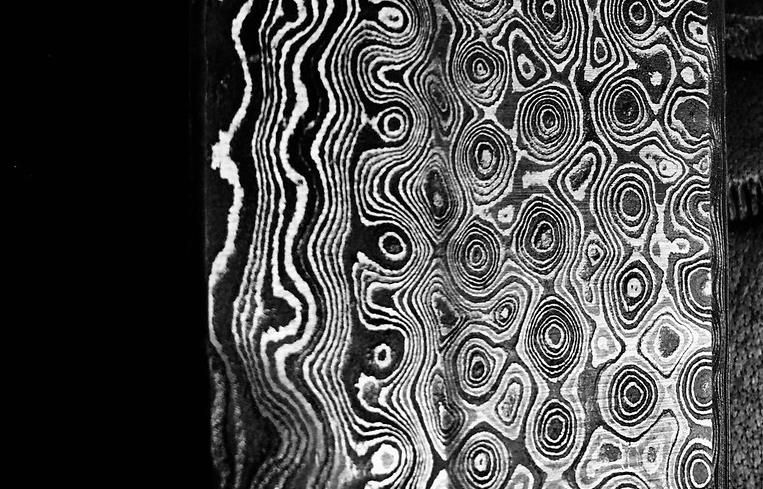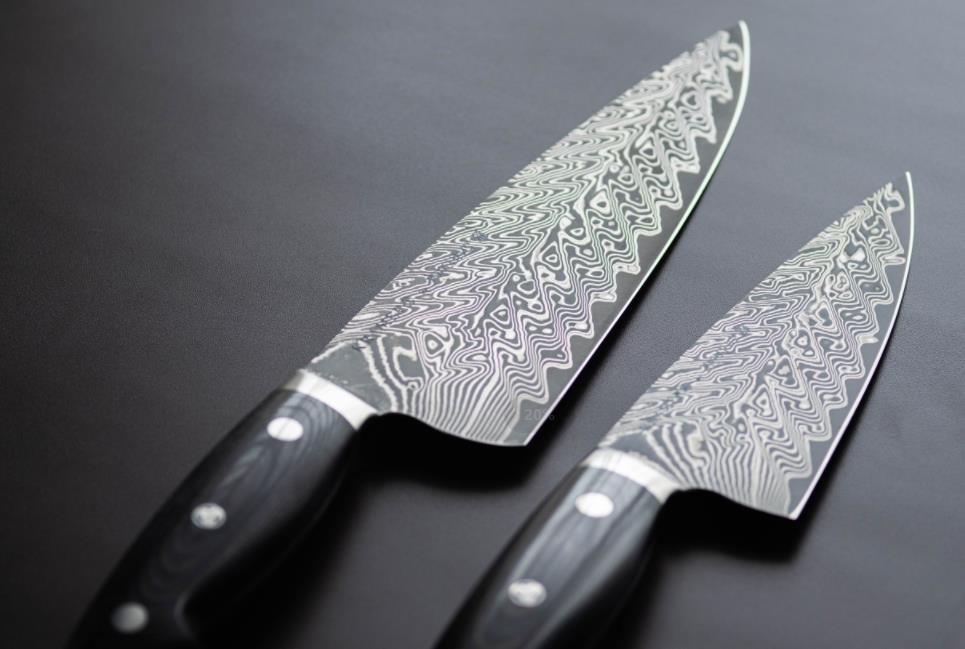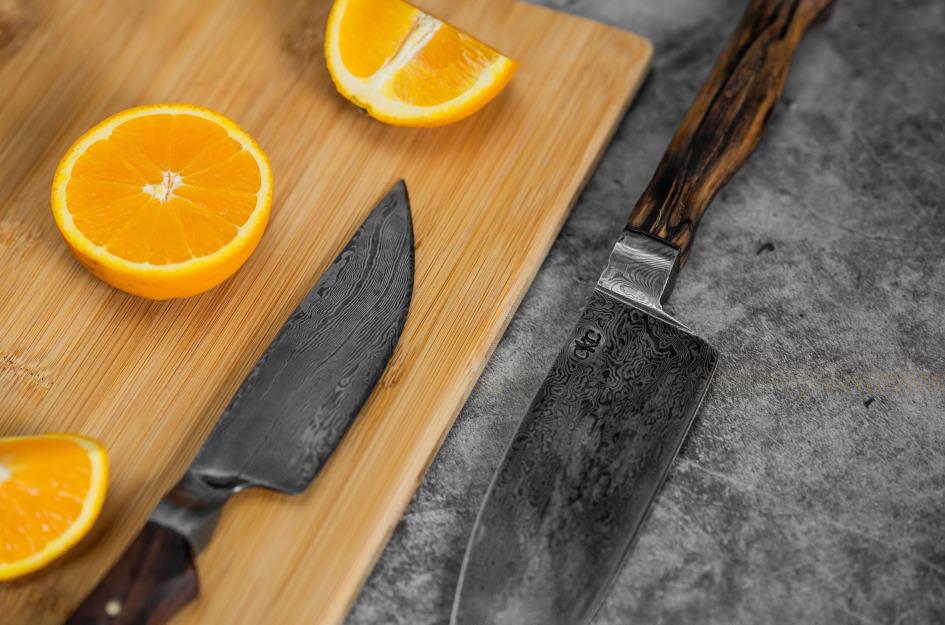Damascus steel’s unique look gathers the attention of anyone who’s shopping for a new blade. Fascinating patterns across the blades naturally occurring make Damascus steel knives highly favorable.
Although they are stunning, the grueling manufacturing process behind Damascus steel comes with a high price tag. With so many imitations, it’s normal to question if a Damascus steel knife you purchased is the real thing or not. Luckily, this article will help you figure out how to tell if Damascus steel is real.
Table of contents
What is Damascus steel?
Damascus steel is a type of steel that has unique designs formed across the blade following the pattern welding forging technique. To put it simply, the blacksmith puts together a few pieces of different steel and forges them together. With rigorous folding, hammering, and twisting, the steel mixes and shows patterns across the surface.
The patterns on Damascus steel appear naturally. It isn’t like a coat of paint. They mark the transition where the steel is mixed and forms together. While this is a very straightforward way to put it for today’s Damascus steel, it wasn’t always this way.
Original and reinvented Damascus steel
The original Damascus steel was fabricated using wootz steel. Historians debate where and how Damascus steel was invented, and many historians believe the technique to produce original Damascus steel was relinquished due to gun production in the 18th century.
There are reproductions of the original Damascus steel now. But it isn’t the same to the modern Damascus steel you can see from Amazon today.
Damascus steel we know today is made by pattern welding technique. As mentioned above, steelmakers put together multiple pieces of steel, forge them together and mix everything. After it is forged and shaped into a blade, knifemakers dip the blade in ferric chloride or muriatic acid to reveal the steel patterns.
What is the Damascus pattern?

There isn’t a single pattern in Damascus steels. Some Damascus steels may have similarities, but not one is identical to another. Still, we can somewhat categorize these different types of Damascus steel patterns.
For example, pressing on concentrated spots during forging creates dimples that resemble a raindrop. This is referred to as the raindrop pattern.
Another method to create a different yet similar outcome is by twisting the steel. Each twist forms a star-like shape that appears similar to mosaics. Here is a short rundown of different Damascus steel patterns and how blacksmiths achieve them.
- Ladder Damascus: Uniformed wavy patterns appear across the blade by pressing on the steel during forging and grinding the grooves. The ladder Damascus pattern is one of the basic ones and easy to make.
- Feathered Damascus: The cycle of continuous heating, hammering, and cooling up to ten steel billets results in a feathered Damascus pattern. This pattern makes the blade seem as if it was a feather with a beautiful straight line in the middle.
- Cable Damascus: Blacksmiths weld steel cables together and forge them to make a knife. The result is each twist showing on the blade as a pattern.
- Spiderweb Damascus: This is a multi-step process and perhaps the most challenging for knifemakers. Spiderweb Damascus requires opposing steel or pure nickel in addition to the steel used. The result is a mosaic-like pattern similar to a spider web following a similar routine across the blade.
Want to learn more about Damascus patterns? Read this in-depth article covering everything about them.
Methods to identify real Damascus steel
There are methods you can follow at home to get an idea of whether your Damascus steel knife is authentic or not. However, there is one critical clarification that needs to be addressed.
Your Damascus steel knife is technically just pattern-welded steel. “Damascus steel” is what we call these steels simply as they look identical to the original steel. Since this makes up 99.99% of Damascus steel knives you can get your hands on, you’re highly likely to be in the wrong if you think it’s the original steel.
Regardless, the following methods to identify if Damascus steel is real or not apply to all.
Examine the blade

It’s nearly impossible to tell if Damascus steel is authentic just by looking at it. Still, there are a few good ways to tell.
Take a look at the location of the patterns. If they run across the blade entirely, fully covering the spine, edge, tang, pretty much the whole blade, it’s a good indication. However, they should be consistent across. If there are different patterns in different parts of the blade, it’s a sign of imitation. The patterns should be the same across regardless of where you’re looking.
While this can help, it doesn’t necessarily mean the patterns are artificial if there are specific areas where they don’t show. Acid etching – dipping the water in ferric chloride or muriatic acid – is the final process for making Damascus steel. Nevertheless, some knife manufacturers give a final polish to the blade. They usually remove the patterns from the spine, edge, and bolster for the cooks to better recognize different parts of the blade.
Price
How much you pay for Damascus steel isn’t always an accurate way to tell if it’s real or not. Still, it can give you an idea.
If you’ve purchased a Damascus steel knife from an individual forging their blades for $40, you can be skeptical. When buying Damascus steel knives for anything under $100 or so, it’s more about where you buy them. With any reputable seller, you’ll have authentic Damascus steel.
While these are fair points, there are cheap Damascus steel knives out there manufactured outside of the US. These Damascus steel knives usually come from parts of Asia and the Middle East, mainly from Pakistan. When the labor costs are significantly cheaper, so are the products. Damascus steel blades are no different.
Again, keep in mind the price and where you buy the Damascus steel knife to see if you’ve paid a fair price or got a cheap imitation.
Best way to differentiate authentic Damascus steel from imitation
Above mentioned methods are only valid to a certain degree. The best and most accurate way to tell if Damascus steel is real is by removing the patterns from the blade. While this is a lot of work, it’s the only way to know if a Damascus steel knife is real or fake.
Here is how to tell if your Damascus steel knife is actually real or not, step by step.
- Using sandpaper, remove the patterns from the entire blade.
- Once the blade is like any other, clean it thoroughly and dry.
- Dip the blade in ferric chloride or muriatic acid without touching the handle for about 15 minutes.
- If the patterns reappear, you got the real deal! If no reaction happens, it’s unfortunately not authentic Damascus steel.
Note that using ferric chloride or muriatic acid substitutes, such as sodium aluminate, ferric sulfate, or phosphoric acid, can hurt the blade. Stick to ferric chloride and muriatic acid when etching knives.
Common misconceptions

Firstly, the most common misconception about the authenticity of Damascus steel knives is the patterns not showing on the spine. As we’ve covered, some knife manufacturers polish these areas.
Just because a Damascus steel knife doesn’t have anything on the spine doesn’t mean it’s fake. The same goes for the edge, tang, or any other part of the knife.
Additionally, one common misunderstanding among people is mistaking Damascus steel for San Mai steel. This is a Japanese construction method mainly for double bevel kitchen knives that utilize two different types of steel. Usually, steel with good edge retention but high brittleness is sandwiched between tough steel. The outcome is a blade that stays sharp for long and is just as tough and durable.
San Mai knives have wavy patterns that might resemble Damascus patterns but are completely different. This design is known as Hamon. It’s prevalent in all-purpose Japanese kitchen knives. If you have wavy patterns on your blade, it’s Hamon design, not Damascus steel. While this might be a bummer, know that it at least has a function to it, unlike Damascus steel.
FAQs about Damascus steel
Can you fake Damascus steel?
If there wasn’t fake Damascus steel, this article would be pointless. Yes, some Damascus steels are fake. Knife manufacturers accomplish similar patterns that naturally occur in real Damascus steel through laser etching. Since this doesn’t require using multiple pieces of steel and forging them together, they are a lot cheaper.
Are Damascus knives good?
Asking whether Damascus knives are good or not is similar to questioning if carbon steel or stainless steel knives are good. It depends on the type of steel used, its properties, and the heat treatment done by the manufacturer. Since Damascus steel knives can have premium-grade or unwanted steel, it can be way more than good or bad.
Do Damascus patterns fade?
Damascus patterns show by acid etching the steel in the final stages. The patterns are there regardless, but this process makes them appear to the eye. Over time, this effect slowly fades away and takes the patterns with it. However, this is a rather slow process. Other factors can also make the Damascus steel patterns fade away, such as patina developing. The dark nature of the patina covers the blade entirely and puts a veil over the patterns.
Can I sharpen Damascus steel knives?
Like all knives, Damascus steel knives can be sharpened using a whetstone. However, the sharpener must show extra care to the blade. Since sharpening any part of the blade other than the edge can remove the patterns, inexperienced sharpeners should consider sending their Damascus steel knives to a professional.
Final words
Damascus patterns have the most unique blade designs in the knife world. Unlike coated blades with artificial additives like titanium carbon nitride or electroless nickel, patterns on Damascus steel occur naturally. The patterns are the reason why Damascus steel is one-of-a-kind knife blade material.
Like any other highly sought product, there are fakes. It might take some work to truly understand if your Damascus steel knife is authentic or not, but knowing that it is will make you value it even more.









